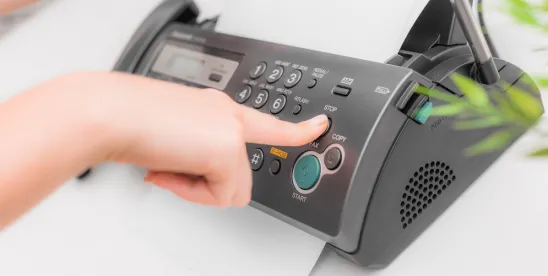Earlier this week, the Supreme Court declined to review a Ninth Circuit ruling regarding what does and doesn’t qualify as an “advertisement.” Supply Pro Sorbents, LLC v. RingCentral, Inc., No. 18-1381, 2019 WL 1959304 (U.S. June 17, 2019).
Fax cover pages were at issue. The defendant in the case allows customers to send online faxes. Those faxes include a cover page with one line of text that identifies the company (“Send and receive faxes with RingCentral”) and its website (“www.ringcentral.com”). The filer alleged that those cover sheets were advertisements, and therefore that the defendant had violated the TCPA because it did not have recipients’ consent to send them.
The Ninth Circuit disagreed. Relying on FCC guidance from 2006, the Ninth Circuit found that the identifying language was at most an “‘incidental advertisement’” that did not “‘convert the entire communication into an advertisement,’ considering ‘the amount of space devoted to advertising versus the amount of space used for information.’” Id. quoting Rules and Regs. Implementing the Tel. Consumer Prot. Act of 1991; Junk Fax Prevention Act of 2005, 71 FR, 25 973 (May 3, 2006).
The plaintiff then filed a petition for writ of certiorari, arguing that the decision creates a split with the Seventh Circuit over what qualifies as an advertisement. Specifically, the plaintiff pointed to the Seventh Circuit’s decision in Ira Holtzman, C.P.A. v. Turza, 728 F.3d 682 (7th Cir. 2013), which held that a fax was an advertisement even though the advertising content took up less than a quarter of the entire page. Id. at 686. In doing so, the Seventh Circuit declined to follow the FCC’s guidance regarding “incidental” marketing language, and instead focused on its reading of the statute. Id. at 686-88. “That 75% of the page is not an ad does not,” the Seventh Circuit reasoned, “detract from the fact that the fax contains an advertisement.” Id.
In its petition for certiorari, the plaintiff in Supply Pro Sorbents argued that the Ninth Circuit and Seventh Circuits now disagree about whether to follow the FCC’s guidance from 2006. For the time being, however, the Supreme Court has declined to review that question.
In other news, yesterday, the Supreme Court punted another fax “advertisement” case back to the Fourth Circuit. PDR Network, LLC v. Carlton & Harris Chiropractic, Inc., No. 17-1705, 2019 WL 2527470, *1 (U.S. June 20, 2019). In Harris Chiropractic, Inc., which will be covered in depth in a separate post, the Court declined to decide whether lower federal courts are bound by the 2006 FCC guidance on “unsolicited” advertisements. Id. Instead, the Court remanded and directed the Fourth Circuit to resolve two preliminary questions—(1) whether the 2006 FCC guidance is the equivalent of a “legislative rule” which has the “force and effect of law,” and (2) whether the plaintiff had a “prior” and “adequate” opportunity for judicial review. Id.





 />i
/>i
